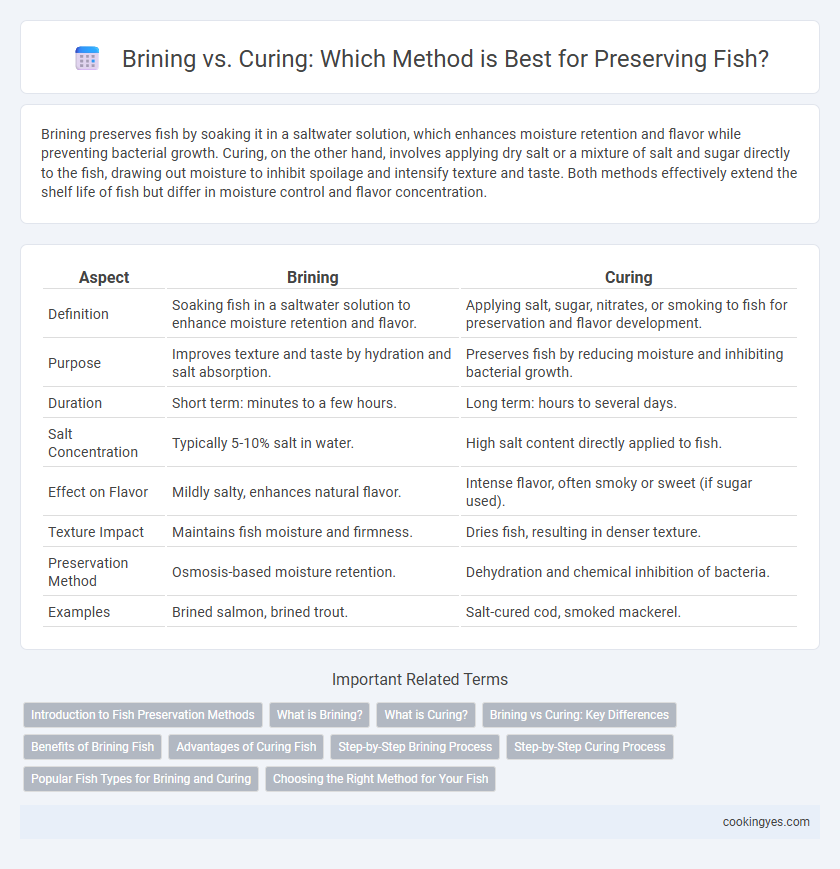Brining preserves fish by soaking it in a saltwater solution, which enhances moisture retention and flavor while preventing bacterial growth. Curing, on the other hand, involves applying dry salt or a mixture of salt and sugar directly to the fish, drawing out moisture to inhibit spoilage and intensify texture and taste. Both methods effectively extend the shelf life of fish but differ in moisture control and flavor concentration.
Table of Comparison
| Aspect | Brining | Curing |
|---|---|---|
| Definition | Soaking fish in a saltwater solution to enhance moisture retention and flavor. | Applying salt, sugar, nitrates, or smoking to fish for preservation and flavor development. |
| Purpose | Improves texture and taste by hydration and salt absorption. | Preserves fish by reducing moisture and inhibiting bacterial growth. |
| Duration | Short term: minutes to a few hours. | Long term: hours to several days. |
| Salt Concentration | Typically 5-10% salt in water. | High salt content directly applied to fish. |
| Effect on Flavor | Mildly salty, enhances natural flavor. | Intense flavor, often smoky or sweet (if sugar used). |
| Texture Impact | Maintains fish moisture and firmness. | Dries fish, resulting in denser texture. |
| Preservation Method | Osmosis-based moisture retention. | Dehydration and chemical inhibition of bacteria. |
| Examples | Brined salmon, brined trout. | Salt-cured cod, smoked mackerel. |
Introduction to Fish Preservation Methods
Brining and curing are essential fish preservation methods that inhibit bacterial growth and extend shelf life by reducing moisture content. Brining involves soaking fish in a saltwater solution to enhance flavor and texture while promoting preservation through osmotic pressure. Curing integrates salt, sugar, and sometimes nitrates, drawing out moisture and developing unique tastes and textures critical for long-term storage.
What is Brining?
Brining is a fish preservation method that involves soaking fish in a saltwater solution to enhance moisture retention and flavor while inhibiting bacterial growth. The salt concentration in the brine creates a hypertonic environment, drawing out excess water from fish tissues and preventing spoilage. Brining not only improves texture and juiciness but also extends the shelf life of fish without significantly altering its natural taste.
What is Curing?
Curing is a preservation method that uses salt, sugar, or other curing agents to draw moisture out of fish, inhibiting bacterial growth and enhancing flavor. This process often involves dry curing or wet curing (using brine) to create an environment unsuitable for spoilage organisms. Cured fish, such as gravlax or smoked salmon, can be stored for extended periods while maintaining texture and taste.
Brining vs Curing: Key Differences
Brining fish involves soaking it in a saltwater solution to enhance moisture retention and flavor, whereas curing uses dry salt or sugar mixtures to draw out moisture and preserve the fish over a longer period. Brining typically requires shorter processing times, often a few hours, while curing can last from several days to weeks, significantly affecting texture and taste. The moisture level retained in brining results in a softer, juicier fish, while curing produces a firmer, denser product with a more concentrated flavor profile.
Benefits of Brining Fish
Brining fish enhances its moisture retention, resulting in a juicier and more flavorful texture after cooking. The salt solution in brining helps inhibit bacterial growth, effectively extending the fish's shelf life while maintaining freshness. This method also allows for better absorption of seasonings, improving the overall taste profile compared to curing techniques.
Advantages of Curing Fish
Curing fish involves the application of salt, sugar, and sometimes nitrates to preserve flavor and texture while inhibiting bacterial growth, extending shelf life significantly. This method enhances the fish's umami and allows for varied culinary uses such as smoking, drying, or fermenting. Curing also reduces moisture content more effectively than brining, preventing spoilage and creating a firmer, more concentrated product.
Step-by-Step Brining Process
Brining fish involves immersing it in a saltwater solution to enhance flavor, moisture retention, and preservation. The step-by-step process includes preparing a brine with a specific salt-to-water ratio, submerging the fish completely, and allowing it to soak for a duration based on fish type and size, typically ranging from 30 minutes to several hours. Proper brining controls texture and taste while inhibiting bacterial growth, making it a preferred method over curing for short-term preservation.
Step-by-Step Curing Process
Curing fish involves a precise step-by-step process starting with cleaning and filleting the fish to remove moisture and impurities. The next stage is applying a curing mixture of salt, sugar, and optional spices evenly to the fish, which draws out moisture and inhibits bacterial growth. Finally, the fish is tightly wrapped and refrigerated for several days to weeks, allowing the cure to penetrate deeply, enhancing flavor and ensuring long-term preservation.
Popular Fish Types for Brining and Curing
Salmon and cod are among the most popular fish types for brining, as their dense flesh absorbs the salty solution well, enhancing moisture retention and flavor. Herring and mackerel are commonly cured using dry salt or sugar-based mixtures, which effectively preserve the fish while developing distinctive textures and tastes. These methods extend shelf life by inhibiting bacterial growth and enzymatic spoilage, crucial for both commercial and artisanal fish preservation.
Choosing the Right Method for Your Fish
Brining fish involves soaking it in a saltwater solution to retain moisture and enhance flavor, ideal for delicate types like salmon or trout. Curing, which uses dry salt or sugar mixes, is better suited for firmer fish such as cod or mackerel, providing longer preservation and a distinct texture. Selecting the right preservation method depends on the fish's texture, desired shelf life, and flavor profile to achieve optimal freshness and taste.
Brining vs Curing for Preserving Fish Infographic

 cookingyes.com
cookingyes.com